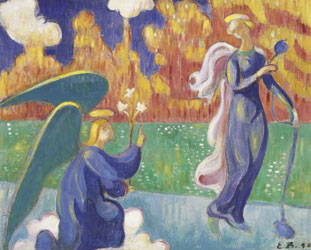Faith and Fervour in the Carmen Thyssen Collection. Simone Martini, Van Dyck, Gauguin
23 March - 30 June 2013Saint Holding a Platter with Roses
n.d. Oil on canvas, 46.3 x 35 cm Carmen Thyssen-Bornemisza Collection on deposit at Museo Thyssen-Bornemisza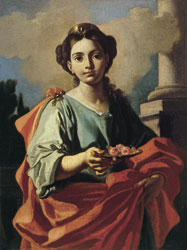
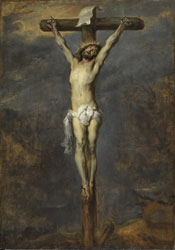
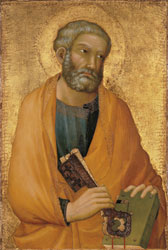
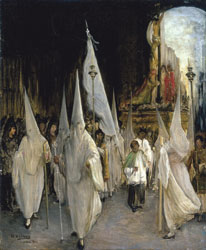
The selected paintings exemplify a range of different styles that together offer a survey of religious painting while revealing the wide variety of both its iconography and iconology. Arranged in chronological order, the first work is St. Peter by Simone Martini, dating from around 1326, in which the founder of the Church is located against a gold background, holding the keys to Heaven. It is a characteristic example of the sophisticated style, brilliant chromatism and poetic line of one of the most important masters of the Italian trecento. Simone’s panel is followed by an anonymous sculpture from Siena; a depiction of the Passion of Christ on a tapestry produced in the workshop of Rubinetto di Francia, which is a chromatically harmonious work made with costly materials including gold and silver thread; and a devotional painting by Niccolò Frangipane that focuses on the moving expression of suffering on the face of Christ, crowned with thorns. Contrasting with these dramatic scenes of the Passion is the youthful and serene beauty of a female saint bearing flowers, attributed to the studio of the Italian painter Jacopo Cestaro.
One of the key works in the present exhibition is the Christ on the Cross by Anthony van Dyck in which the rapid, agitated brushstroke is balanced by the gravity of the sacrifice depicted. It conveys the deeply-felt spirituality of a profoundly Catholic artist whose works express his fervent devotion. Simplicity is the key to Gauguin’s Sketch for ‘The Yellow Christ’ of 1884. This is a small-format work painted in a simplified manner and with a powerful brushstroke. Gauguin’s depiction of the crucified Christ as inspired by a 17th-century polychrome sculpture that he saw in the Trémalo chapel on the outskirts of Pont-Aven near to where he lived during his years in Brittany.
It the artist’s Gauguin’s particular state of mind at this period, his growing religiosity and his reflections on the meaning of human spirituality, an issue that would continue to interest him to the end of his life in Tahiti. The mystery of the Annunciation is represented in Émile Bernard’s interpretation of this subject with its elegant figures and archaic aesthetic that pays tribute to the Italian painters of the Early Renaissance. Painted in 1890, it is characteristic of the artist’s Synthetism with its harmonious combination of the arabesque, incandescent colour and pronounced decorative sense.
The discovery by artists such as Alfred Dehodencq, Joseph Saint-Germier and Gonzalo Bilbao of the traditional imagery of the Passion of Christ to be seen in Easter Week processions led them to depict such scenes in their canvases within the genre of costumbrismo painting, which focused on picturesque scenes of daily life and customs.
In Andalusia, the Passion has been the subject of rich and multi-faceted interpretations aimed at arousing the emotions of the viewer. Elements used to encourage these sentiments include the smell of incense, the symbolism of colour, the uplifting effect of music and the wealth of decorative elements such as opulent goldsmith’s work and embroidery. Together they contribute to creating a unique environment in which the emphasis is not only on the images but also on the procession itself, the participants in their austere tunics and extinguished candles, and above all the religious fervour of the onlookers as they wait with enormous expectation for the procession to pass by, playing their part in this great theatrical, Baroque ritual that is re-enacted on the streets of southern Spain.

